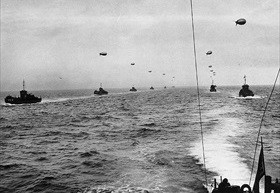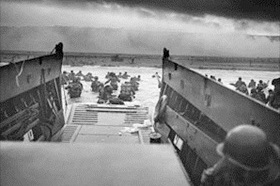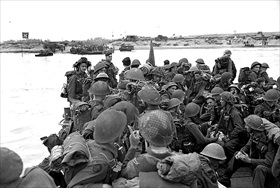EISENHOWER TAKES COMMAND OF LIBERATION ARMY
London, England · January 15, 1944
On this date in 1944 Gen. Dwight D. Eisenhower assumed command of the Allied Expeditionary Force preparing to liberate France from the stranglehold of Adolf Hitler’s Nazi Germany. A month earlier President Franklin D. Roosevelt had designated the 53‑year‑old army general Supreme Allied Commander for Operation Overlord, the invasion of northwestern Europe and Germany. Ever since June 1940, when British and French troops escaped from the beaches of Dunkirk, France, where they faced almost certain annihilation, the Germans knew that an invasion of Festung Europa (Fortress Europe) would come—they just didn’t know when or where. Thus the invasion planners had to throw the enemy off track by leading them to believe that the invasion would take place in the Pas de Calais on the northern coast of France, which was only a few miles across the Channel from England, the invasion staging ground. This ruse, which included fake Allied armies, fake army headquarters, and dummy radio traffic, was so successful that Hitler and his generals continued to believe it up until D‑Day. Furthermore, the planners had to shut down a German counterattack on the true site of the invasion, the beaches of Normandy. This required fleets of bombers to attack the transportation networks that would facilitate German reinforcements of men, equipment, and fuel reaching Normandy, as well as Allied fighter aircraft to keep enemy aircraft at bay while the troops stormed ashore. Assisting in the effort was a slew of French resistance forces engaged in covert and sabotage operations designed to harass and obstruct German reinforcements. Finally, the invasion plan depended on assembling enough landing craft to shuttle nine divisions inside 24 hours to the assault beaches (Sword, Juno and Gold for the British and Canadians, and Omaha and Utah for the Americans). In fact, the lack of sufficient landing craft forced the planners to shift the invasion from May to June 1944. The plan came together. The Normandy landings on June 6, 1944, were costly but successful. They were followed a month later by landings in southern France (Operation Dragoon). Between D‑Day and the end of August 1944, Nazi tyranny was driven from most of France.
![]()
[amazon_carousel widget_type=”ASINList” width=”600″ height=”200″ title=”Recommended Reading” market_place=”US” shuffle_products=”False” show_border=”False” asin=”0743244745,0307946622,0743449746,1853674273,1586484621,0306813556,0684856298,0307888754,0143118188,0306814226″ /]
D-Day, June 6, 1944, Normandy, Northwest France
 |  |
Left: A large landing craft convoy crosses the English Channel on June 6, 1944. The majority of troops who landed on the D‑Day beaches were from the Great Britain (112,824), the U.S. (52,889), and Canada (18,000). Close to 5,000 troops from other Allied countries participated in the D-Day landings and the ensuing Battle of Normandy (June 6 to August 30, 1944). They were drawn from Australia, Belgium, Czechoslovakia, France, Greece, the Netherlands, New Zealand, Norway, and Poland.
![]()
Right: An American LCVP (Landing Craft Vehicle Personnel) approaches Omaha Beach, Normandy, France, June 6. Smoke on the shore emanates from German positions. The assault phase of Operation Overlord was known as Operation Neptune. This operation involved landing the troops on the beaches, as well as all other associated supporting operations required to establish a beachhead in France. Operation Neptune began on D‑Day and ended on June 30, 1944.
 |  |
Left: “Into the Jaws of Death” is the description of this photo taken of the 16th Infantry, 1st Infantry Division (the Big Red One) wading onto the Fox Green section of Omaha Beach at 8:30 on the morning of June 6. An earlier wave of B‑26 Martin Marauder twin-engine bombers had not even scratched the German defenses on the 3.5‑mile stretch of beach—the 13,000 bombs dropped missed their target by 3 miles. The U.S. 1st and 29th Divisions together suffered around 2,000 casualties (two-thirds of Company E were killed or wounded) as they advanced up Omaha Beach into 4 batteries of artillery, 18 antitank guns, 6 mortar pits, 35 rocket launcher sites, 8 concrete bunkers, 35 pillboxes, and 85 machine-gun nests. A high casualty rate of officers left many low-ranking soldiers leaderless and confused on the invasion beach. By day’s end, however, a lodgment had been effected.
![]()
Right: Members of an American landing party lend helping hands to others of their unit whose landing craft or DD (duplex drive) amphibious tank was sunk by enemy shore guns, high seas, or mines. Thirty-two landing craft and most DD tanks were lost this way. The survivors in this photo reached Omaha Beach by using a life raft.
 |  |
Left: British Second Army infantry wait to move off Queen White section, Sword Beach, while under enemy fire on the morning of June 6. By nightfall the British had 28,850 men ashore and had seized the bridge over the River Orne, a principle objective that day.
![]()
Right: Personnel of Royal Canadian Navy Beach Commando “W” land on Mike section, Juno Beach of the Normandy beachhead, June 6. Juno was the most exposed of the five invasion beaches, and the opposition awaiting the Canadians was believed greater than that facing any other Allied force. By the time they had secured Juno Beach, one in six Canadians was dead or wounded.
 |  |
Left: Assault troops of the 3rd Battalion, 16th Infantry Regiment, 1st U.S. Infantry Division, having gained the comparative safety offered by the chalk cliff at their backs, take a breather before moving into the interior. Omaha Beach, Normandy, June 8.
![]()
Right: American craft of all styles put cargo ashore at low tide during the first stages of the Allied invasion. Omaha Beach, Normandy, June 1944.
Still Scenes, Maps, Music, and Commentary by On-Scene Reporters: A Tribute to the D‑Day Landings, June 6, 1944
![]()

 History buffs, there is good news! The Daily Chronicles of World War II is now available as an ebook for $4.99 on Amazon.com. Containing a year’s worth of dated entries from this website, the ebook brings the story of this tumultuous era to life in a compelling, authoritative, and succinct manner. Featuring inventive navigation aids, the ebook enables readers to instantly move forward or backward by month and date to different dated entries. Simple and elegant! Click
History buffs, there is good news! The Daily Chronicles of World War II is now available as an ebook for $4.99 on Amazon.com. Containing a year’s worth of dated entries from this website, the ebook brings the story of this tumultuous era to life in a compelling, authoritative, and succinct manner. Featuring inventive navigation aids, the ebook enables readers to instantly move forward or backward by month and date to different dated entries. Simple and elegant! Click 











